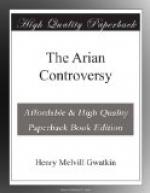[Sidenote: Interval of rest (346-353.)]
The next few years were an uneasy interval of suspense rather than of peace, for the long contest had so far decided nothing. If the Nicene exiles were restored, the Eusebian disturbers were not deposed. Thus while Nicene animosity was not satisfied, the standing grounds of conservative distrust were not removed. Above all, the return of Athanasius was a personal humiliation for Constantius, which he was not likely to accept without watching his opportunity for a final struggle to decide the mastery of Egypt. Still there was tolerable quiet for the present. The court intriguers could do nothing without the Emperor, and Constantius was occupied first with the Persian war, then with the civil war against Magnentius. If there was not peace, there was a fair amount of quiet till the Emperor’s hands were freed by the death of Magnentius in 353.
[Sidenote: Modification of Nicene position.]
The truce was hollow and the rest precarious, but the mere cessation of hostilities was not without its influence. As Nicenes and conservatives were fundamentally agreed on the reality of the Lord’s divinity, minor jealousies began to disappear when they were less busily encouraged. The Eusebian phase of conservatism, which emphasised the Lord’s personal distinction from the Father, was giving way to the Semiarian, where stress was rather laid on his essential likeness to the Father. Thus ’of a like essence’ (homoiousion) and ‘like in all things’ became more and more the watchwords of conservatism. The Nicenes, on the other side, were warned by the excesses of Marcellus that there was some reason for the conservative dread of the Nicene ‘of one essence’ (homoousion) as Sabellian. The word could not be withdrawn, but it might be put forward less conspicuously, and explained rather as a safe and emphatic form of the Semiarian ‘of like essence’ than as a rival doctrine. Henceforth it came to mean absolute likeness of attributes rather than common possession of the divine essence. Thus by the time the war is renewed, we can already foresee the possibility of a new alliance between Nicenes and conservatives.




